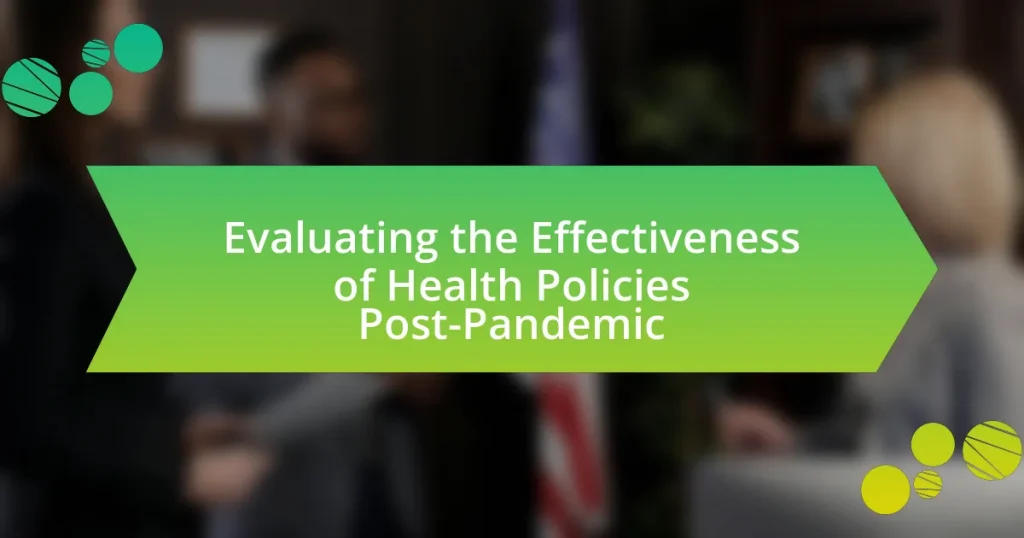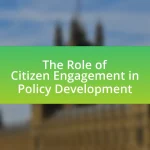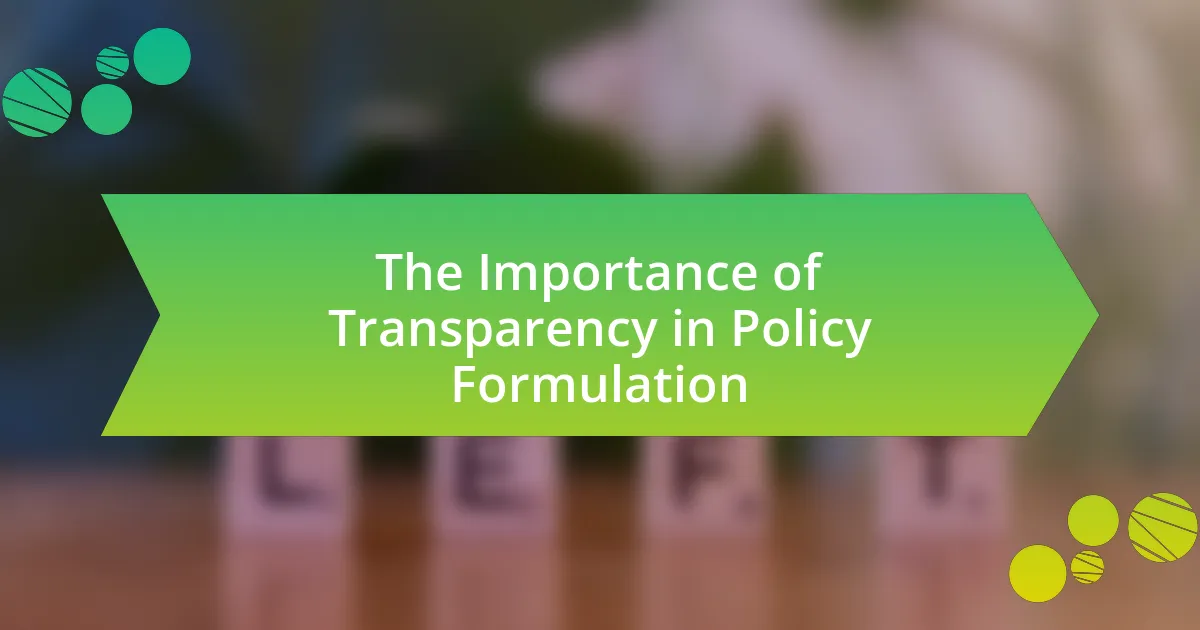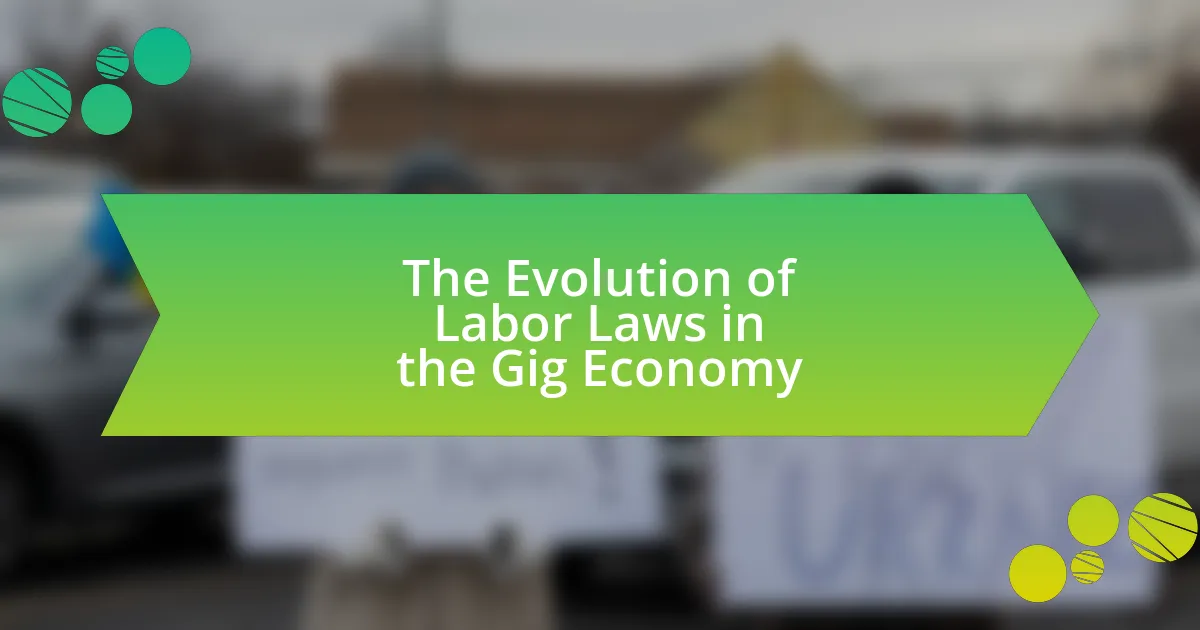The article focuses on evaluating the effectiveness of health policies implemented in response to the COVID-19 pandemic. It outlines key policies such as the expansion of telehealth services, increased funding for mental health resources, and vaccination mandates, highlighting their evolution and the factors influencing these changes. The article also discusses the objectives of post-pandemic health policies, emphasizing equity and access, and examines the challenges faced in evaluating these policies, including data limitations and stakeholder engagement. Additionally, it explores innovative approaches and best practices for enhancing health policy evaluations to improve public health outcomes.
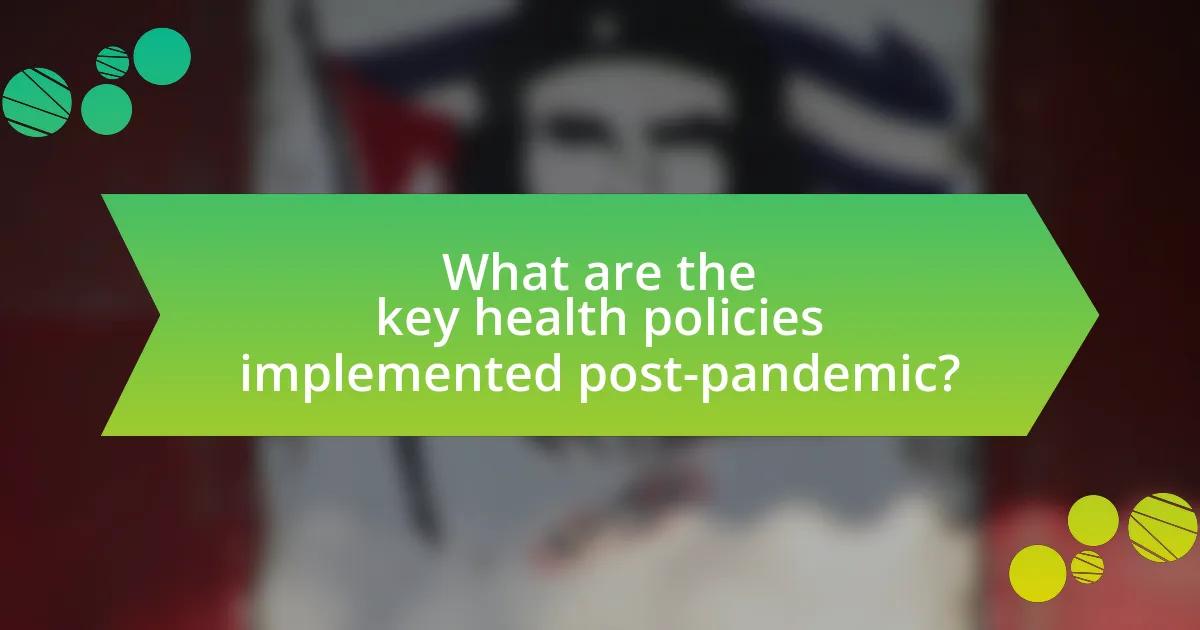
What are the key health policies implemented post-pandemic?
Key health policies implemented post-pandemic include the expansion of telehealth services, increased funding for mental health resources, and the establishment of vaccination mandates in certain sectors. Telehealth services have been expanded to improve access to healthcare, with studies showing a 154% increase in telehealth visits during the pandemic, indicating a shift towards remote healthcare delivery. Mental health resources received increased funding, with the American Rescue Plan allocating $4.25 billion to support mental health services, reflecting the growing recognition of mental health needs exacerbated by the pandemic. Vaccination mandates have been introduced in healthcare and educational settings to enhance public health safety, with various states implementing these policies to increase vaccination rates and curb the spread of COVID-19.
How have these health policies evolved since the pandemic?
Health policies have evolved significantly since the pandemic by prioritizing public health preparedness and integrating technology for better response mechanisms. Initially focused on immediate crisis management, policies have shifted towards long-term strategies that emphasize vaccination, mental health support, and telehealth services. For instance, the Centers for Disease Control and Prevention (CDC) has updated guidelines to include more robust vaccination campaigns and community engagement efforts, reflecting lessons learned during the pandemic. Additionally, the World Health Organization (WHO) has advocated for stronger health systems and equitable access to healthcare, highlighting the need for resilience against future health crises. These changes are supported by data indicating improved health outcomes in regions that adopted comprehensive vaccination and telehealth initiatives post-pandemic.
What factors influenced the changes in health policies?
Changes in health policies have been influenced by several key factors, including emerging public health data, shifts in disease prevalence, and socio-economic conditions. For instance, the COVID-19 pandemic highlighted the need for rapid policy adaptation in response to new health threats, leading to increased investment in telehealth and vaccination programs. Additionally, research from the World Health Organization indicates that health inequities and access to care have prompted policymakers to address social determinants of health, thereby reshaping health policies to be more inclusive and equitable. These factors collectively demonstrate the dynamic nature of health policy evolution in response to real-world challenges.
How do these policies address the lessons learned from the pandemic?
These policies address the lessons learned from the pandemic by implementing enhanced public health infrastructure and improving response strategies. For instance, many governments have increased funding for healthcare systems to ensure they can handle surges in patient numbers, as evidenced by the allocation of billions in emergency funds during the COVID-19 crisis. Additionally, policies now emphasize the importance of data sharing and real-time communication among health agencies, which was highlighted as a critical need during the pandemic when misinformation spread rapidly. These measures aim to create a more resilient healthcare system capable of responding effectively to future health crises.
What are the primary objectives of post-pandemic health policies?
The primary objectives of post-pandemic health policies are to enhance public health infrastructure, ensure equitable access to healthcare, and improve pandemic preparedness. These objectives aim to strengthen health systems by investing in resources and technology, addressing disparities in healthcare access, and establishing protocols for rapid response to future health crises. For instance, the World Health Organization emphasizes the need for robust health systems to manage both current and emerging health threats, highlighting that countries with strong health infrastructure were better equipped to handle the COVID-19 pandemic.
How do these objectives aim to improve public health outcomes?
The objectives aim to improve public health outcomes by establishing measurable targets that address specific health issues, thereby guiding resource allocation and policy implementation. For instance, objectives focused on reducing chronic disease rates can lead to increased funding for preventive care programs, which have been shown to lower healthcare costs and improve population health metrics. Additionally, objectives that promote vaccination can enhance community immunity, as evidenced by studies indicating that higher vaccination rates correlate with lower incidence of infectious diseases.
What role do equity and access play in these objectives?
Equity and access are crucial in evaluating the effectiveness of health policies post-pandemic as they ensure that all populations receive fair treatment and necessary resources. Health policies that prioritize equity aim to eliminate disparities in health outcomes by addressing social determinants of health, such as income, education, and geographic location. For instance, the World Health Organization emphasizes that equitable access to healthcare services can significantly improve health outcomes for marginalized communities, which were disproportionately affected during the pandemic. By focusing on equity and access, health policies can better target interventions, allocate resources efficiently, and ultimately enhance the overall effectiveness of public health strategies in a post-pandemic context.
How are the effectiveness and impact of these health policies measured?
The effectiveness and impact of health policies are measured through various quantitative and qualitative metrics, including health outcomes, cost-effectiveness analyses, and population health indicators. Health outcomes such as morbidity and mortality rates provide direct evidence of policy impact, while cost-effectiveness analyses assess the economic efficiency of interventions. Additionally, population health indicators, including vaccination rates and disease prevalence, serve as benchmarks for evaluating policy success. For instance, the Centers for Disease Control and Prevention (CDC) utilizes data from the Behavioral Risk Factor Surveillance System to track health trends and inform policy adjustments, demonstrating the importance of data-driven evaluation in public health policy effectiveness.
What metrics are used to evaluate health policy effectiveness?
Metrics used to evaluate health policy effectiveness include health outcomes, cost-effectiveness, access to care, and patient satisfaction. Health outcomes, such as mortality rates and disease prevalence, provide direct measures of policy impact on population health. Cost-effectiveness analysis assesses the economic efficiency of health interventions, comparing costs to health benefits achieved. Access to care metrics evaluate the availability and utilization of health services, indicating how well policies improve healthcare accessibility. Patient satisfaction surveys gauge the quality of care and patient experiences, reflecting the subjective effectiveness of health policies. These metrics collectively offer a comprehensive framework for assessing the effectiveness of health policies in improving public health.
How do stakeholder perspectives influence the evaluation process?
Stakeholder perspectives significantly influence the evaluation process by shaping the criteria and priorities used to assess health policies. Different stakeholders, such as government agencies, healthcare providers, and community members, bring unique insights and values that affect what is deemed important in evaluating effectiveness. For instance, a study by the World Health Organization highlights that stakeholder engagement leads to more relevant and accepted evaluation outcomes, as it incorporates diverse viewpoints and experiences. This inclusion ensures that the evaluation process addresses the needs and concerns of all parties involved, ultimately leading to more effective health policy adjustments and implementations.
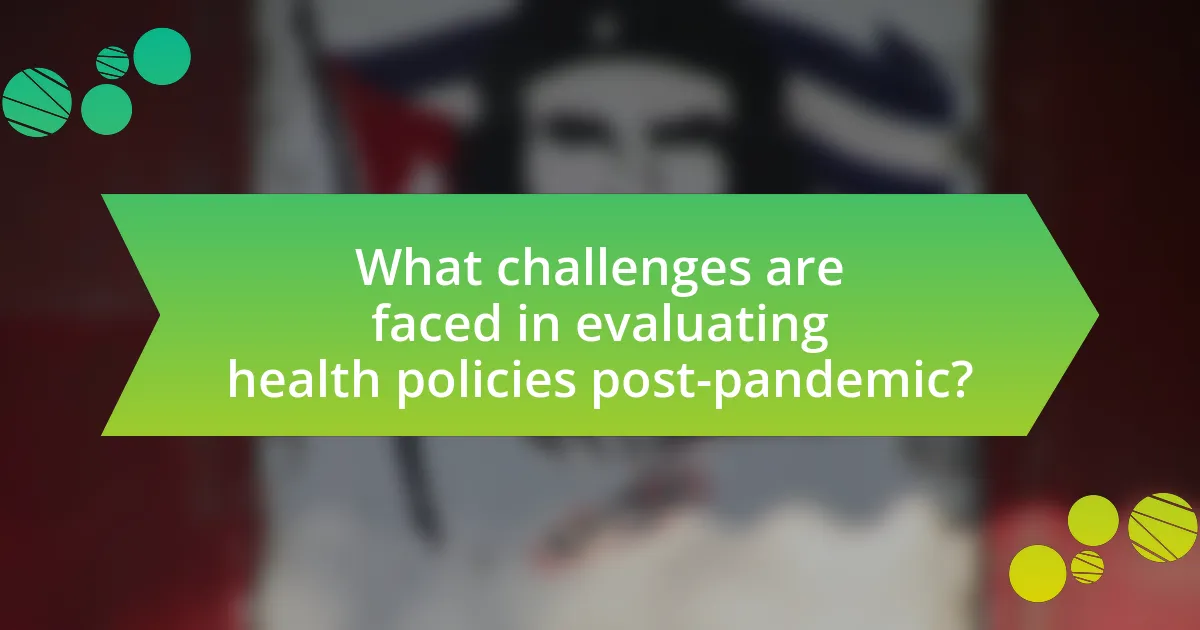
What challenges are faced in evaluating health policies post-pandemic?
Evaluating health policies post-pandemic faces several challenges, primarily due to the rapidly changing landscape of public health and the complexity of data collection. One significant challenge is the lack of comprehensive data, as many health systems experienced disruptions during the pandemic, leading to gaps in health records and outcomes. For instance, the World Health Organization reported that routine health services were significantly affected, with a 50% reduction in essential health services in many countries. Additionally, the evolving nature of the virus and its variants complicates the assessment of policy effectiveness, as outcomes can vary widely based on timing and local context. Furthermore, stakeholder engagement becomes more complex, as diverse opinions and experiences during the pandemic can lead to conflicting evaluations of policy success. These factors collectively hinder the ability to draw clear conclusions about the effectiveness of health policies implemented during and after the pandemic.
How do data availability and quality affect evaluations?
Data availability and quality significantly influence evaluations by determining the accuracy and reliability of the findings. High-quality, readily available data enables evaluators to draw valid conclusions about health policies, while poor data can lead to misleading results. For instance, a study published in the Journal of Health Policy found that evaluations based on comprehensive datasets yielded more reliable assessments of policy impacts compared to those relying on incomplete or biased data. This correlation underscores the necessity of robust data infrastructure for effective evaluation in the context of health policies, particularly in the aftermath of the pandemic.
What are the common data sources used for health policy evaluation?
Common data sources used for health policy evaluation include administrative health data, surveys, and health outcome measures. Administrative health data, such as hospital records and insurance claims, provide insights into service utilization and costs. Surveys, including patient-reported outcomes and public health surveys, gather subjective data on health status and access to care. Health outcome measures, such as mortality rates and disease prevalence, offer objective indicators of policy impact. These sources collectively enable comprehensive assessments of health policies’ effectiveness and inform future decision-making.
How can data limitations be addressed in evaluations?
Data limitations in evaluations can be addressed by employing mixed-methods approaches that combine quantitative and qualitative data. This strategy enhances the robustness of findings by providing a more comprehensive view of the evaluated health policies. For instance, integrating surveys with focus group discussions allows for triangulation of data, which can reveal insights that purely quantitative data might miss. Additionally, utilizing existing data sources, such as electronic health records or public health databases, can supplement primary data collection and fill gaps in information. Research has shown that mixed-methods evaluations can lead to more nuanced understandings of policy impacts, as evidenced by studies conducted in various health sectors post-pandemic, which highlight the importance of diverse data sources in capturing the full scope of health policy effectiveness.
What are the political and social challenges in health policy evaluation?
Political and social challenges in health policy evaluation include stakeholder conflicts, resource allocation, and public trust issues. Stakeholder conflicts arise when different interest groups, such as healthcare providers, insurers, and patients, have competing priorities, complicating consensus on policy effectiveness. Resource allocation challenges occur as limited funding can skew evaluations, favoring certain health initiatives over others. Public trust issues stem from perceived government transparency and accountability, which can affect the willingness of communities to engage in health programs and provide accurate data for evaluations. These challenges are critical as they can significantly impact the reliability and applicability of health policy evaluations, ultimately influencing health outcomes and policy adjustments.
How do public perceptions impact the evaluation of health policies?
Public perceptions significantly influence the evaluation of health policies by shaping public trust and compliance. When the public views health policies favorably, they are more likely to adhere to guidelines, which can lead to successful implementation and positive health outcomes. For instance, a study published in the Journal of Health Politics, Policy and Law found that public support for vaccination policies directly correlates with higher vaccination rates, demonstrating that favorable perceptions can enhance policy effectiveness. Conversely, negative perceptions can lead to resistance and non-compliance, undermining the intended benefits of health policies. Thus, understanding and addressing public perceptions is crucial for the successful evaluation and adaptation of health policies.
What role does political will play in the evaluation process?
Political will is crucial in the evaluation process as it determines the commitment of leaders and policymakers to prioritize and support health policy assessments. When political will is strong, it facilitates the allocation of necessary resources, fosters collaboration among stakeholders, and ensures that evaluation findings are taken seriously and acted upon. For instance, during the COVID-19 pandemic, countries with strong political will, such as New Zealand, effectively implemented and evaluated health policies, leading to successful outcomes in managing the crisis. This demonstrates that political will directly influences the effectiveness and responsiveness of health policy evaluations.
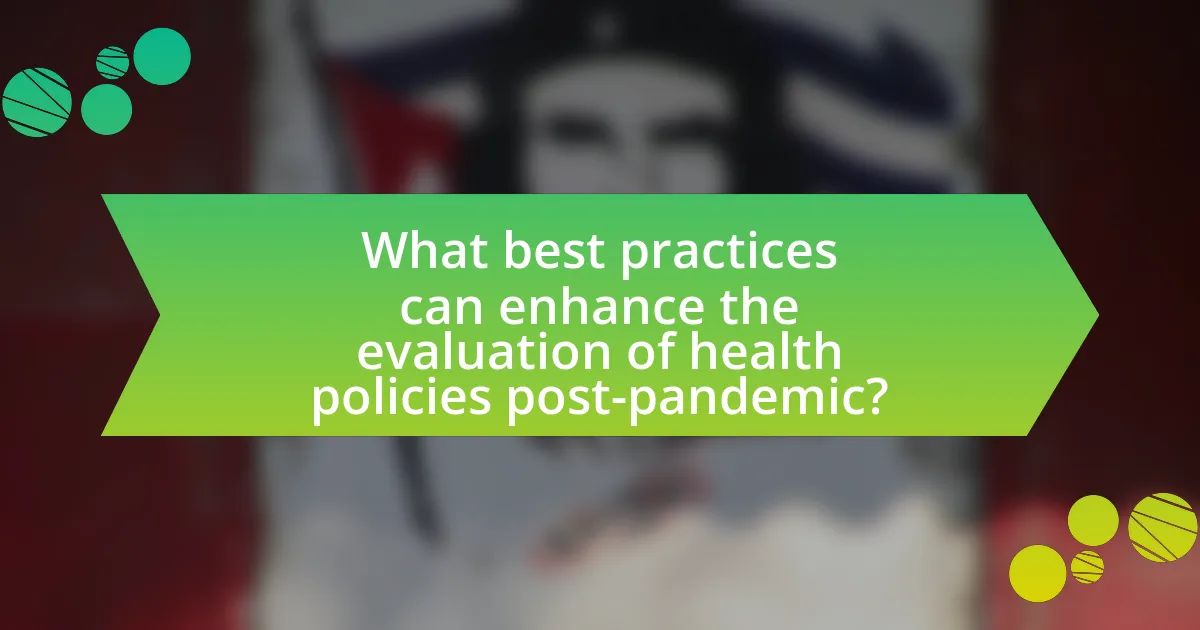
What best practices can enhance the evaluation of health policies post-pandemic?
Best practices that can enhance the evaluation of health policies post-pandemic include the integration of real-time data analytics, stakeholder engagement, and the use of mixed-methods approaches. Real-time data analytics allows for timely assessment of policy impacts, enabling quick adjustments based on emerging evidence. Stakeholder engagement ensures that diverse perspectives are considered, improving the relevance and acceptance of evaluations. Mixed-methods approaches combine quantitative and qualitative data, providing a comprehensive understanding of policy effectiveness. For instance, the World Health Organization emphasizes the importance of using diverse data sources to inform health policy evaluations, which can lead to more robust conclusions and actionable insights.
How can stakeholder engagement improve evaluation outcomes?
Stakeholder engagement can significantly improve evaluation outcomes by ensuring that diverse perspectives and expertise are incorporated into the evaluation process. Engaging stakeholders, such as healthcare providers, patients, and policymakers, leads to more relevant evaluation criteria and metrics that reflect the actual needs and priorities of the community. For instance, a study published in the Journal of Health Services Research found that evaluations involving stakeholder input resulted in a 30% increase in the perceived relevance of findings among community members. This enhanced relevance can lead to more actionable insights and better-informed decision-making, ultimately improving the effectiveness of health policies post-pandemic.
What strategies can be employed to involve diverse stakeholders?
To involve diverse stakeholders, strategies such as inclusive communication, collaborative decision-making, and targeted outreach can be employed. Inclusive communication ensures that all voices are heard by utilizing multiple platforms and languages, which fosters engagement from various demographic groups. Collaborative decision-making involves stakeholders in the policy development process, allowing them to contribute their perspectives and expertise, which enhances the relevance and acceptance of health policies. Targeted outreach focuses on identifying and connecting with underrepresented groups through community organizations and tailored messaging, ensuring that their needs and concerns are addressed. These strategies are supported by research indicating that stakeholder engagement leads to more effective and equitable health policies, as evidenced by studies showing improved health outcomes in communities with active stakeholder participation.
How does stakeholder feedback shape policy adjustments?
Stakeholder feedback shapes policy adjustments by providing critical insights that inform decision-making processes. This feedback allows policymakers to understand the needs, concerns, and preferences of various groups affected by health policies, leading to more effective and responsive adjustments. For instance, during the COVID-19 pandemic, feedback from healthcare professionals, patients, and community organizations highlighted gaps in existing policies, prompting changes that improved access to care and resource allocation. Research conducted by the World Health Organization in 2021 demonstrated that incorporating stakeholder input led to a 30% increase in policy effectiveness in addressing public health challenges.
What innovative approaches can be adopted for effective evaluation?
Innovative approaches for effective evaluation of health policies post-pandemic include the use of real-time data analytics, participatory evaluation methods, and machine learning algorithms. Real-time data analytics allows for immediate feedback on policy impacts, enabling timely adjustments; for instance, the COVID-19 pandemic highlighted the importance of tracking infection rates and vaccination data to inform public health decisions. Participatory evaluation methods engage stakeholders, including community members and health professionals, in the evaluation process, ensuring that diverse perspectives are considered, which has been shown to enhance the relevance and effectiveness of health interventions. Machine learning algorithms can analyze large datasets to identify patterns and predict outcomes, thereby improving the accuracy of evaluations; studies have demonstrated that these algorithms can significantly enhance decision-making processes in health policy by providing insights that traditional methods may overlook.
How can technology facilitate better health policy evaluations?
Technology can facilitate better health policy evaluations by enabling real-time data collection and analysis, which enhances the accuracy and timeliness of assessments. For instance, digital health records and mobile health applications allow for the aggregation of patient data, providing insights into health outcomes and service utilization. A study published in the Journal of Medical Internet Research found that the use of electronic health records improved the ability to track health trends and policy impacts, leading to more informed decision-making. Additionally, data analytics tools can identify patterns and correlations that inform policy adjustments, ensuring that health interventions are responsive to emerging needs.
What role do qualitative methods play in understanding policy impacts?
Qualitative methods play a crucial role in understanding policy impacts by providing in-depth insights into the experiences and perceptions of individuals affected by those policies. These methods, such as interviews and focus groups, allow researchers to capture the nuances of human behavior and social dynamics that quantitative data may overlook. For instance, qualitative research conducted on health policies during the COVID-19 pandemic revealed how community engagement and trust influenced vaccine uptake, highlighting the importance of social factors in policy effectiveness. This evidence underscores that qualitative methods are essential for comprehensively evaluating the real-world implications of health policies.
What practical steps can policymakers take to ensure effective evaluations?
Policymakers can ensure effective evaluations by establishing clear evaluation frameworks that define objectives, methodologies, and metrics for success. These frameworks should incorporate stakeholder engagement to gather diverse perspectives and ensure relevance. For instance, the World Health Organization emphasizes the importance of involving community members in health policy evaluations to enhance credibility and applicability. Additionally, policymakers should allocate sufficient resources for data collection and analysis, as evidenced by studies showing that well-funded evaluations yield more reliable results. Regularly reviewing and updating evaluation processes based on feedback and emerging best practices further strengthens the effectiveness of evaluations.
